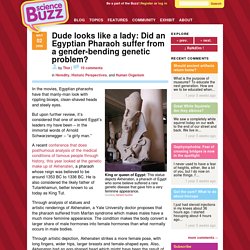

Dude looks like a lady: Did an Egyptian Pharaoh suffer from a gender-bending genetic problem? King or queen of Egypt: This statue depicts Akhenaten, a pharaoh of Egypt who some believe suffered a rare genetic disease that gave him a very feminine appearance.Courtesy Gérard DucherIn the movies, Egyptian pharaohs have that manly-man look with rippling biceps, clean-shaved heads and steely eyes.

But upon further review, it’s considered that one of ancient Egypt’s leaders my have been – in the immortal words of Arnold Schwarzenegger – “a girly man.” A recent conference that does posthumous analysis of the medical conditions of famous people through history, this year looked at the genetic make up of Akhenaten, a pharaoh whose reign was believed to be around 1353 BC to 1336 BC. He is also considered the likely father of Tutankhamun, better known to us today as King Tut. Through analysis of statues and artistic renderings of Akhenaten, a Yale University doctor proposes that the pharaoh suffered from Marfan syndrome which makes males have a much more feminine appearance. Akhenaten Deformities. For immediate release: May 02, 2008 Akhenaten, a pharaoh during Egypt's 18th Dynasty - best known for transforming Egypt's religious system from worship of multiple gods to the worship of one god - may have had two medical abnormalities that could explain his portrayal in sculpture and carvings with an exaggerated female appearance and elongated head.

Questions about Akhenaten abound. Were his artisans following his orders to employ an artistic style for some religious purpose? Or did he really look this bizarre, and if so, why? These questions form the backdrop for the 14th annual Historical Clinicopathological Conference (CPC), sponsored by the University of Maryland School of Medicine and the Veterans Affairs (VA) Maryland Health Care System in Baltimore. The 2008 Historical CPC will be held Friday, May 2, from 1:30 to 3:00 p.m., in Davidge Hall (522 W. Art-based diagnosis With only artwork to guide a medical diagnosis of Akhenaten, the creator of the Historical CPC, Philip A. Dr. Dr. Mysteries of Akhenaten. Akhenaten: Egyptian Pharaoh, Nefertiti's Husband, Tut's Father.
Akhenaten was a pharaoh of Egypt who reigned over the country for about 17 years between roughly 1353 B.C. and 1335 B.C.

A religious reformer he made the Aten, the sun disc, the center of Egypt’s religious life and carried out an iconoclasm that saw the names of Amun, a pre-eminent Egyptian god, and his consort Mut, be erased from monuments and documents throughout Egypt’s empire. When he ascended the throne his name was Amenhotep IV, but in his sixth year of rule he changed it to “Akhenaten” a name that the late Egyptologist Dominic Montserrat translated roughly as the “Benevolent one of (or for) the Aten.”
Error loading player: No playable sources found In honor of the Aten, he constructed an entirely new capital at an uninhabited place, which we now call Amarna, out in the desert. Its location was chosen so that its sunrise conveyed a symbolic meaning. He notes that this capital would quickly grow to become about 4.6 square miles (roughly 12 square kilometers) in size.
. — Owen Jarus. The Androgynous Pharaoh? Akhenaten had feminine physique. By Alex Dominguez, Associated Press Writer BALTIMORE — Akhenaten wasn't the most manly pharaoh, even though he fathered at least a half-dozen children.

In fact, his form was quite feminine, which has puzzled experts for years. And he was a bit of an egghead. Dr. Irwin Braverman, a Yale University physician who analyzed images of Akhenaten, has a new theory on why. The female form was due to a genetic mutation that caused the pharaoh's body to convert more male hormones to female hormones than needed, Braverman believes. The pharaoh had "an androgynous appearance. Braverman, who sizes up the health of individuals based on portraits, teaches a class at Yale's medical school that uses paintings from the university's Center for British Art to teach observation skills to first-year students. Akhenaten (ah-keh-NAH-ten), best known for introducing a revolutionary form of monotheism to ancient Egypt, reigned in the mid-1300s B.C. Egyptologist and archaeologist Donald B.